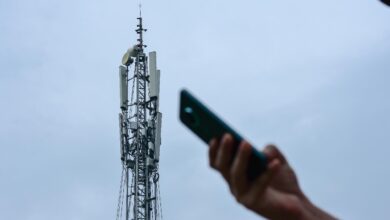Exploring Semiconductor Lasers for Telecommunications

The importance of semiconductor lasers for the information and telecommunication sectors is unparalleled. Semiconductor lasers are a specific type of solid-state laser utilizing semiconductors as an active medium to amplify signals. Recently, fiber optics-based telecommunication networks have been the most preferred choice, with every optical link equipped with semiconductor lasers inside. Semiconductor lasers have served as the backbone for the rapid commercialization of telecommunications and Datacom industries.
Image Credit: Oleksiy Mark/Shutterstock.com
Applications of Vertical-cavity Surface-Emitting Semiconductor Lasers in Data Communication
A specific type of semiconductor laser termed the hetero-structure laser is essential in modern telecommunications operations. Researchers have published an article in Photonics Research stating that vertical-cavity surface-emitting lasers (VCSEL) are the ideal type of optical semiconductor lasers intended for data communications and sensing applications.
Vertical-cavity surface-emitting Lasers (VCSELs) are the primary optical sources for optical links based on multimode fiber (MMF) in data centers and high-performance computers (HPCs). Recent designs in telecommunication systems aim to enhance VCSE semiconductor lasers to be more energy-efficient and capable of sustaining high modulation bit rates at room temperature without requiring adjustments to the operating parameters, even at elevated temperatures.
These special semiconductor lasers are expected to maintain their dominance in data centers, especially in the domains of chip-to-chip and on-chip optical interconnects. VCSELs characterized by Single-mode operation with a narrow spectral range in modern telecommunication systems are being optimized for long-distance transmission over multimode fiber. This advancement is expected to play a vital role in fast and uninterrupted data transmission.
What are Telecom-Band Lasers?
The development of compact and powerful semiconductor lasers that span the entire wavelength range of 1.2 to 1.6 μm is crucial for the operation of telecommunication systems. A major technological advancement occurred in 2019 when a team of Japanese researchers utilized optically pumped InP/InAs for the development of nano-wire semiconductor lasers operating in a specific range of telecommunications, known as the telecom-band laser.
The precise wavelength control was achieved by adjusting the thickness of the InAs quantum-well layer, ranging from 6.8 to 9.0 nm. The nanowires, with a diameter of about 1 μm and length of 10 μm, were excited by an 800 nm wavelength picosecond laser. Photoluminescence measurements at room temperature indicated a lasing threshold in the range of 1.4 to 4.2 mJ cm–2, depending on the excitation power. These semiconductor lasers are the most optimized and efficient lasers, providing higher levels of efficiency during the data flow of telecommunication systems.
Nanoscale Quantum Dot Semiconductor Lasers
Modern technological advancements are essential for a safe and sustainable future of the human race. In 5G and 6G telecommunication networks, swift and low-latency communications facilitate the interconnection of diverse endpoints. A common requirement in these critical applications is a laser source to execute intricate tasks at ultra-fast speeds, enabling broadband, secure, and energy-efficient communications.
Nanostructured Semiconductor lasers such as quantum dots in recent times are highly preferred for optical telecommunication devices. As per the article published in IOP Conf. Series: Materials Science and Engineering, Quantum dot lasers play a crucial role in the telecommunication sector, especially in optical communication, driven by the demand for advanced technology and high optical gain.
The concept of quantum dots for semiconductor lasers was introduced in 1982. Quantum dot lasers are preferred because of their lower temperature dependence as compared to conventional semiconductor lasers. Their superior quantum confinement, as compared to quantum well lasers, results in better tunability for quantum dot lasers.
The research study mentions that a nitride-based red laser with the help of InGaN/GaN quantum dots laser has been developed. Designing laser arrays can be complex, so a single-band laser operating at a high power of 635nm was preferred. The structure involved a single quantum well of GaInP. Specific applications involving data storage, especially in the telecommunications network and digital video disks, utilize this particular semiconductor laser.
Microwave signals have diverse applications in sensing, space communications, millimeter-wave, terahertz signal generation, and cellular 5G networks. A recent article in Light: Science and Applications states that semiconductor lasers operating under optical injection prove highly effective for microwave generation.
Optical injection (OI) involves injecting light from a master laser into the cavity of a slave laser. The stable local minimum of the microwave frequency for quantum dot (QD) semiconductor lasers remains robust against variations in injection power. These characteristics are conducive to the advancement of future on-chip semiconductor laser-based microwave sources, offering cost-effectiveness and energy efficiency.
Machine Learning for Predictive Maintenance of Semiconductor Lasers in the Telecommunication Sector
Semiconductor lasers, an essential component for optical communication systems, are undergoing rapid technological advancements, including high speed, low power consumption, and compact form factors to fulfill the demands of next-generation telecommunication networks. However, these requirements pose significant challenges to the reliability of semiconductor lasers. Research studies are being conducted all over the world to find an effective solution.
In the Journal of Lightwave Technology, the researchers proposed a predictive maintenance framework employing machine learning techniques for real-time health monitoring and prognosis of semiconductor lasers employed in telecommunications.
The approach consists of three stages, the first one being real-time performance degradation prediction, utilizing an attention-based gated recurrent unit (GRU) model. It is followed by Degradation detection, employing a convolutional auto-encoder to identify abnormal behavior or degradation. In the last step, a deep-learning model is used to estimate the Remaining useful life (RUL). The estimated RUL is then used for decision-making and maintenance planning.
The proposed approach demonstrated excellent capabilities in predicting degradation performance, achieving a small root mean square error (RMSE) of 0.01. Additionally, it exhibited high accuracy in anomaly detection, reaching 94.24%.
Semiconductor lasers are necessary for the efficient operation of telecommunication systems. With new materials discovery and progress in the fields of quantum-based semiconductor lasers, the telecommunication sector is expected to see a major boost in the coming years.
More from AZoOptics: What is Photonic Quantum Sensing?
References and Further Reading
Liu, A. et. al. (2019). Vertical-cavity surface-emitting lasers for data communication and sensing. Photonics Research, 7(2), 121-136. Available at: https://doi.org/10.1364/PRJ.7.000121
Horiuchi, N. (2019). Telecom-band laser. Nat. Photonics 13. 303. Available at: https://doi.org/10.1038/s41566-019-0432-4
Vijay, J. et. al. (2019, August). Structural and optical characteristics of nanoscale semiconductor lasers for telecommunication and biomedical applications: a review. In IOP Conference Series: Materials Science and Engineering. Vol. 594 (1). 012002. IOP Publishing. Available at: https://www.doi.org/10.1088/1757-899X/594/1/012002
Grillot, F. et al. (2021). Uncovering recent progress in nanostructured light-emitters for information and communication technologies. Light Sci Appl 10, 156. Available at: https://doi.org/10.1038/s41377-021-00598-3
Abdelli. K. et. al. (2022). A Machine Learning-Based Framework for Predictive Maintenance of Semiconductor Laser for Optical Communication. Journal of Lightwave Technology. 40 (14). 4698-4708. Available at: https://www.doi.org/10.1109/JLT.2022.3163579



